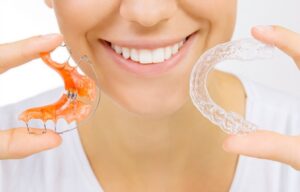
If your teeth have started to shift after braces or Invisalign, you might be wondering: Can I just use my old retainer to push them back into place? It’s a common question, especially if the thought of restarting orthodontic treatment sounds overwhelming. Using your old retainer to re-straighten your teeth can work in some cases, but it also carries risks. Here’s what you need to know.
Why Teeth Shift After Braces
After orthodontic treatment, your teeth need time to stabilize in their new positions. This is why retainers are essential; they hold your teeth in place as the surrounding bone and tissue adapt. If you stop wearing your retainer regularly, your teeth can gradually drift out of alignment. This shifting can happen over months or even years.
Can an Old Retainer Still Fit?
The first thing to check is whether your old retainer even fits. If it’s been a long time since you’ve worn it, you might find that it feels tight or uncomfortable. In some cases, it might not fit at all. If your teeth have shifted significantly, forcing an ill-fitting retainer into place can cause pain, damage, or even worsen the alignment.
If your retainer still fits snugly without causing pain, it might be able to hold your teeth where they are, or even gently guide them back into better alignment. But this should only be attempted under the guidance of a dental professional.
The Risks of Using an Old Retainer
While it might be tempting to use your old retainer as a DIY fix, there are several risks:
- Improper Fit: If your retainer no longer fits your teeth precisely, it can place uneven pressure on them, leading to discomfort or damage.
- Cracks or Wear: Old retainers may be weakened from age or use, making them less effective or prone to breaking.
- Unsupervised Movement: Teeth need to be moved carefully and in the right sequence. Using a retainer not designed for your current dental situation could result in bite problems or gum recession.
What You Should Do Instead
The best first step is to schedule a visit with your orthodontist. They can assess how much your teeth have moved and determine the best course of action. In some cases, your old retainer can be used temporarily to prevent further shifting. In others, you may need a new retainer or a short course of aligner treatment to correct the relapse.
Modern orthodontic solutions, like clear aligners, are often quicker and more affordable than you might expect, especially if only minor corrections are needed.
While your old retainer might seem like a convenient solution to shifting teeth, it’s not always safe or effective to use it without professional input. If your smile isn’t looking as straight as it used to, don’t wait – talk to your dentist. With the right guidance, you can restore your smile safely and efficiently without risking further problems.
About the Author
Dr. Nathan Larson is a graduate of the Midwestern University’s College of Dental Medicine. After graduating, he joined the U.S. Air Force and spent a year doing an Advanced Education in General Dentistry Residency followed by a residency at the University of Texas at Houston, where he became a board-certified orthodontist. Dr. Larson and our team can offer different orthodontic appliances including removable or fixed retainers and temporary anchorage devices. Schedule your appointment today through our website or call our office at (623) 400-3234.
